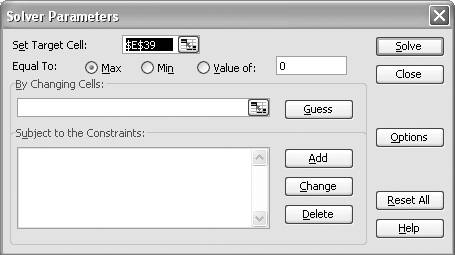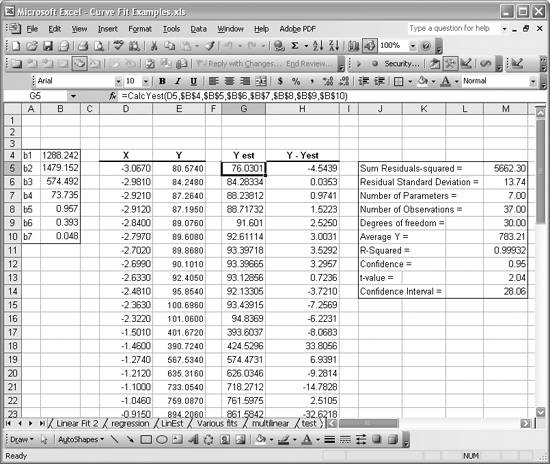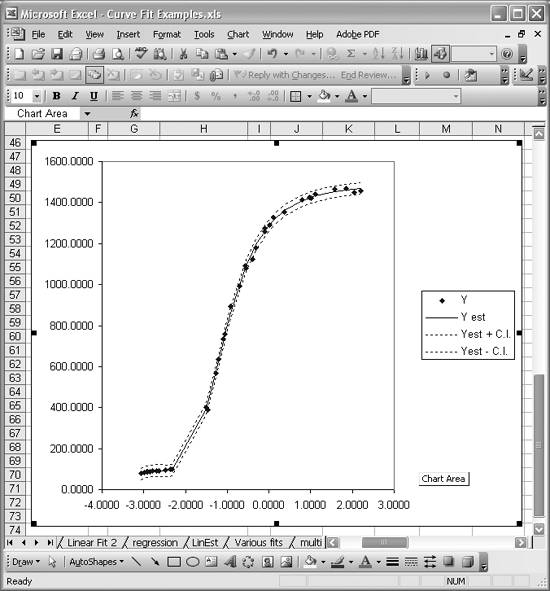Fitting Nonlinear Curves Using Solver
Problem
You'd like to perform a curve fit using a model (an equation) that's not included in Excel's suite of curve fit functions and trendlines.
Solution
Perform a least-squares curve fit using Solver.
Discussion
Solver is a fantastic Excel add-in that allows you to perform constrained optimization calculations. Solver uses the nonlinear Generalized Reduced Gradient optimization algorithm developed by Leon Lasdon and Allan Waren. Go to the Tools images/U2192.jpg border=0> Solver menu to open the Solver dialog box shown in Figure 8-10.
Figure 8-10. Solver dialog box

If you don't see the Solver menu item, then go to Tools images/U2192.jpg border=0> Add-Ins...and look for Solver in the available add-ins list. Select its checkbox to make it available.
Solver allows you to choose a target cell and either maximize it, minimize it, or attempt to set its value to some specified value by changing values in a given range of cells. The controls in the Solver dialog box allow you to set these parameters. After setting these parameters in the Solver dialog box, press Solve to initiate the iterative calculation. Solver will iterate until it finds a solution or until certain limits are reached (these effectively put the brakes on the iterative calculation so it will not continue forever). You can set these limits by opening the Options dialog via the Options button.
The target cell could be any cell containing a formula. That formula could contain references to other cells, which could themselves contain formulas, and so on. Ultimately, the value in the target cell will be affected by certain parameters contained in a select group of cells or a single cell. You can construct arbitrarily complex spreadsheets that somehow relate the target cell to one or more cells containing values, such as constants or coefficients. This is really powerful. You can create spreadsheets to compute something subject to a given set of inputs and then you can use Solver to find the optimum set of inputs to maximize, minimize, or specify the output. It's this facility that we'll leverage to use Solver for nonlinear curve fitting.
Ultimately, curve fitting involves minimizing some error, which can be expressed as the sum of squared differences between actual and predicted values as in the least-squares method. You could use some other merit function instead of the sum of squared residuals. For example, you could choose to maximize the coefficient of determination, R-squared, instead.
The basic approach to using Solver for curve fitting is to set up a spreadsheet containing sample data for your dependent and independent variables. The dependent variable will be predicted using some model (i.e., an equation) that you devise. Set up another column for predictions of your dependent variable using your model equation. Add another column containing the residuals (i.e., the differences between your predicted value and the actual value of the dependent variable). Compute the sum of squared differences in another cell. In the case of minimizing the sum of squared differences, you can set this cell as the target cell in the Solver dialog box. Set the option to minimize that cell. Your model equation must contain parameters, or coefficients. These should be located conveniently in another set of cells. Use references to these cells as the cells to change in the Solver dialog box. Solver will then attempt to minimize the sum of squared differences with the end result, if it succeeds, being the set of parameters that yield the optimum solution. This gives you the curve fit.
Let's look at an example. We'll consider a standard reference set of data available from the NIST web site. In this case, the data is from an NIST study involving semi-conductor electron mobility where the dependent variable, y, is a measure of electron mobility, and the independent variable, x, is the natural log of the density.[*] The model for this data is nonlinear and of the following form:
[*] This dataset is credited to R. Thurber of NIST and is available for download from http://www.nist.gov.

The bs in this equation are the parameters to be determined through the fitting processes. There are seven of them. Clearly, this nonlinear, rational function is not included in Excel's suite of curve-fitting tools. This illustrates the generality of using Solver for curve fittingyou can use any model equation you want.
Figure 8-11 shows a portion of the data used for this example. There are 37 data points contained in columns D and E. As you can see, I set up a little table of b-coefficients off to the left. These are set up with some initial values that you must choose. These cells don't contain formulas. Just type the numbers in directly; Solver will change them during its calculations.
Figure 8-11. Example data

|
Column G contains the estimated y-value for each x-value in the dataset. This estimated y-value uses the model equation. In this case, I coded the model equation in a custom VBA function called CalcYest (see Recipe 2.2). CalcYest is shown in Example 8-1.
Example 8-1. CalcYest
Function CalcYest(x As Double, b1 As Double, b2 As Double, b3 As Double, b4 As Double, b5 As Double, b6 As Double, b7 As Double) As Double CalcYest = (b1 + b2 * x + b3 * x ^ 2 + b4 * x ^ 3) / (1 + b5 * x + b6 * x ^ 2 + b7 * x ^ 3) End Function |
This function takes the x-value along with all seven b-parameters as arguments and returns the estimated y-value. You'll notice in Figure 8-11 that cell G5 is selected. Take a look at the formula bar to see how CalcYest is actually used as a cell formula.
The table off to the right in Figure 8-11 contains several statistics that I computed for this example. I'll address most of these later (see Recipes 8.7 and 8.8), so for now just look at cell M5. That cell contains the sum of squared residuals. The residuals are computed in column H and are simply the estimated y-values minus the sampled y-values. The sum of squared residuals is computed in cell M5 with the formula =SUMSQ(H5:H41). SUMSQ is Excel's built-in function that computes the sum of the squares of the values contained in the given range. It's this value we want to minimize for the curve fit.
With things set up as described, you can now open Solver and set the parameters. First set the target cell to M5, the sum of squared residuals. Next select the "Equal to: Min" option, letting Solver know we want to minimize the value contained in M5. Enter the cell range B4:B10 in the By Changing Cells field. Press the Solve button. At this point, another dialog box will open, showing the results of Solver's calculations. Solver will tell you whether or not it converged on a solution and will give you the option of saving its results or restoring your original values (the values of the parameters you allowed Solver to change).
The converged results for this example are already shown in Figure 8-11. The b-parameters computed here agree very well with the NIST benchmark results. Further, the R-squared value for this example is 0.99932, indicating a good fit. Figure 8-12 shows the results plotted on a chart along with the original data. The original data points are shown with diamond point markers, and the estimated values are shown with the solid curve. The two other curves above and below the estimate curve represent the 95% confidence interval for the predicted values. See Recipe 8.8 to learn how to compute these curves.
Figure 8-12. Solver curve-fit results

Clearly, this approach using Solver yields a nice curve fit to a fairly nonlinear set of data. I must say that not all nonlinear curve fits are this straightforward. I've had some very unruly cases involving multiple nonlinear models, where a different local minimum was converged upon for virtually every set of guessed input parameters I could imagine. In other cases, the model was such that Solver could not converge on a solution at all. These aren't necessarily a defect in this approach or a deficiency in Solver. Those of you who've experienced such difficulties firsthand know that it's just the nature of some highly nonlinear problems to make your life difficult.
Using Excel
- Introduction
- Navigating the Interface
- Entering Data
- Setting Cell Data Types
- Selecting More Than a Single Cell
- Entering Formulas
- Exploring the R1C1 Cell Reference Style
- Referring to More Than a Single Cell
- Understanding Operator Precedence
- Using Exponents in Formulas
- Exploring Functions
- Formatting Your Spreadsheets
- Defining Custom Format Styles
- Leveraging Copy, Cut, Paste, and Paste Special
- Using Cell Names (Like Programming Variables)
- Validating Data
- Taking Advantage of Macros
- Adding Comments and Equation Notes
- Getting Help
Getting Acquainted with Visual Basic for Applications
- Introduction
- Navigating the VBA Editor
- Writing Functions and Subroutines
- Working with Data Types
- Defining Variables
- Defining Constants
- Using Arrays
- Commenting Code
- Spanning Long Statements over Multiple Lines
- Using Conditional Statements
- Using Loops
- Debugging VBA Code
- Exploring VBAs Built-in Functions
- Exploring Excel Objects
- Creating Your Own Objects in VBA
- VBA Help
Collecting and Cleaning Up Data
- Introduction
- Importing Data from Text Files
- Importing Data from Delimited Text Files
- Importing Data Using Drag-and-Drop
- Importing Data from Access Databases
- Importing Data from Web Pages
- Parsing Data
- Removing Weird Characters from Imported Text
- Converting Units
- Sorting Data
- Filtering Data
- Looking Up Values in Tables
- Retrieving Data from XML Files
Charting
- Introduction
- Creating Simple Charts
- Exploring Chart Styles
- Formatting Charts
- Customizing Chart Axes
- Setting Log or Semilog Scales
- Using Multiple Axes
- Changing the Type of an Existing Chart
- Combining Chart Types
- Building 3D Surface Plots
- Preparing Contour Plots
- Annotating Charts
- Saving Custom Chart Types
- Copying Charts to Word
- Recipe 4-14. Displaying Error Bars
Statistical Analysis
- Introduction
- Computing Summary Statistics
- Plotting Frequency Distributions
- Calculating Confidence Intervals
- Correlating Data
- Ranking and Percentiles
- Performing Statistical Tests
- Conducting ANOVA
- Generating Random Numbers
- Sampling Data
Time Series Analysis
- Introduction
- Plotting Time Series Data
- Adding Trendlines
- Computing Moving Averages
- Smoothing Data Using Weighted Averages
- Centering Data
- Detrending a Time Series
- Estimating Seasonal Indices
- Deseasonalization of a Time Series
- Forecasting
- Applying Discrete Fourier Transforms
Mathematical Functions
- Introduction
- Using Summation Functions
- Delving into Division
- Mastering Multiplication
- Exploring Exponential and Logarithmic Functions
- Using Trigonometry Functions
- Seeing Signs
- Getting to the Root of Things
- Rounding and Truncating Numbers
- Converting Between Number Systems
- Manipulating Matrices
- Building Support for Vectors
- Using Spreadsheet Functions in VBA Code
- Dealing with Complex Numbers
Curve Fitting and Regression
- Introduction
- Performing Linear Curve Fitting Using Excel Charts
- Constructing Your Own Linear Fit Using Spreadsheet Functions
- Using a Single Spreadsheet Function for Linear Curve Fitting
- Performing Multiple Linear Regression
- Generating Nonlinear Curve Fits Using Excel Charts
- Fitting Nonlinear Curves Using Solver
- Assessing Goodness of Fit
- Computing Confidence Intervals
Solving Equations
- Introduction
- Finding Roots Graphically
- Solving Nonlinear Equations Iteratively
- Automating Tedious Problems with VBA
- Solving Linear Systems
- Tackling Nonlinear Systems of Equations
- Using Classical Methods for Solving Equations
Numerical Integration and Differentiation
- Introduction
- Integrating a Definite Integral
- Implementing the Trapezoidal Rule in VBA
- Computing the Center of an Area Using Numerical Integration
- Calculating the Second Moment of an Area
- Dealing with Double Integrals
- Numerical Differentiation
Solving Ordinary Differential Equations
- Introduction
- Solving First-Order Initial Value Problems
- Applying the Runge-Kutta Method to Second-Order Initial Value Problems
- Tackling Coupled Equations
- Shooting Boundary Value Problems
Solving Partial Differential Equations
- Introduction
- Leveraging Excel to Directly Solve Finite Difference Equations
- Recruiting Solver to Iteratively Solve Finite Difference Equations
- Solving Initial Value Problems
- Using Excel to Help Solve Problems Formulated Using the Finite Element Method
Performing Optimization Analyses in Excel
- Introduction
- Using Excel for Traditional Linear Programming
- Exploring Resource Allocation Optimization Problems
- Getting More Realistic Results with Integer Constraints
- Tackling Troublesome Problems
- Optimizing Engineering Design Problems
- Understanding Solver Reports
- Programming a Genetic Algorithm for Optimization
Introduction to Financial Calculations
- Introduction
- Computing Present Value
- Calculating Future Value
- Figuring Out Required Rate of Return
- Doubling Your Money
- Determining Monthly Payments
- Considering Cash Flow Alternatives
- Achieving a Certain Future Value
- Assessing Net Present Worth
- Estimating Rate of Return
- Solving Inverse Problems
- Figuring a Break-Even Point
Index
EAN: 2147483647
Pages: 206

